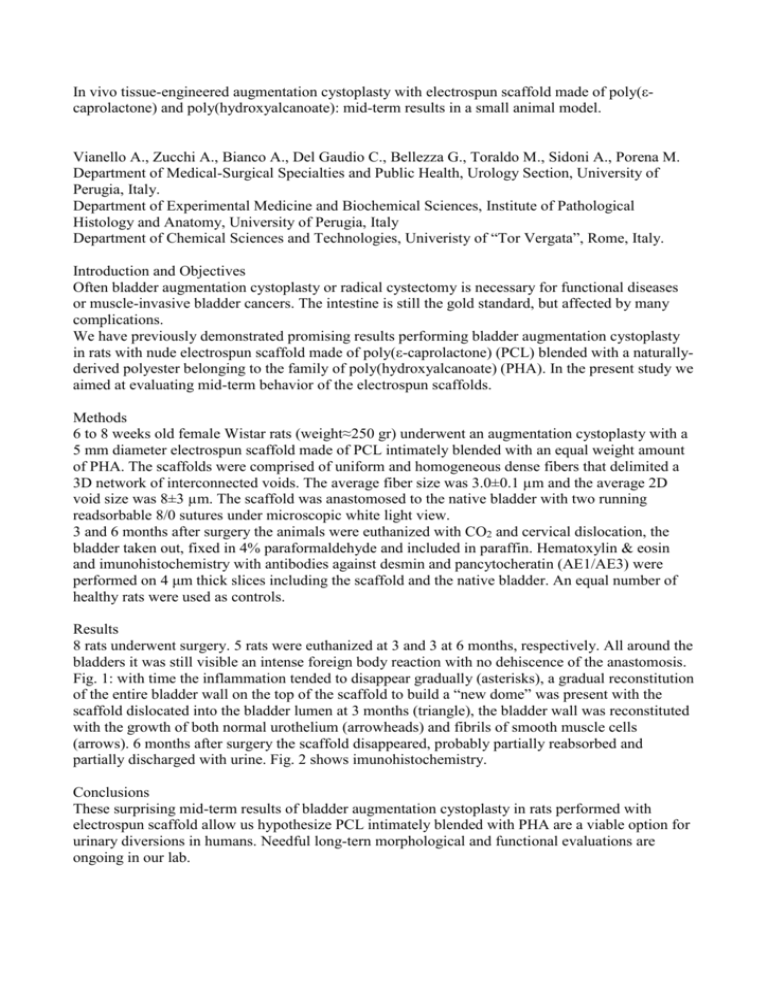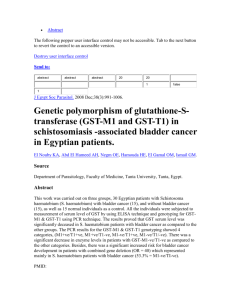Vianello A
advertisement

In vivo tissue-engineered augmentation cystoplasty with electrospun scaffold made of poly(εcaprolactone) and poly(hydroxyalcanoate): mid-term results in a small animal model. Vianello A., Zucchi A., Bianco A., Del Gaudio C., Bellezza G., Toraldo M., Sidoni A., Porena M. Department of Medical-Surgical Specialties and Public Health, Urology Section, University of Perugia, Italy. Department of Experimental Medicine and Biochemical Sciences, Institute of Pathological Histology and Anatomy, University of Perugia, Italy Department of Chemical Sciences and Technologies, Univeristy of “Tor Vergata”, Rome, Italy. Introduction and Objectives Often bladder augmentation cystoplasty or radical cystectomy is necessary for functional diseases or muscle-invasive bladder cancers. The intestine is still the gold standard, but affected by many complications. We have previously demonstrated promising results performing bladder augmentation cystoplasty in rats with nude electrospun scaffold made of poly(ε-caprolactone) (PCL) blended with a naturallyderived polyester belonging to the family of poly(hydroxyalcanoate) (PHA). In the present study we aimed at evaluating mid-term behavior of the electrospun scaffolds. Methods 6 to 8 weeks old female Wistar rats (weight≈250 gr) underwent an augmentation cystoplasty with a 5 mm diameter electrospun scaffold made of PCL intimately blended with an equal weight amount of PHA. The scaffolds were comprised of uniform and homogeneous dense fibers that delimited a 3D network of interconnected voids. The average fiber size was 3.0±0.1 µm and the average 2D void size was 8±3 µm. The scaffold was anastomosed to the native bladder with two running readsorbable 8/0 sutures under microscopic white light view. 3 and 6 months after surgery the animals were euthanized with CO2 and cervical dislocation, the bladder taken out, fixed in 4% paraformaldehyde and included in paraffin. Hematoxylin & eosin and imunohistochemistry with antibodies against desmin and pancytocheratin (AE1/AE3) were performed on 4 μm thick slices including the scaffold and the native bladder. An equal number of healthy rats were used as controls. Results 8 rats underwent surgery. 5 rats were euthanized at 3 and 3 at 6 months, respectively. All around the bladders it was still visible an intense foreign body reaction with no dehiscence of the anastomosis. Fig. 1: with time the inflammation tended to disappear gradually (asterisks), a gradual reconstitution of the entire bladder wall on the top of the scaffold to build a “new dome” was present with the scaffold dislocated into the bladder lumen at 3 months (triangle), the bladder wall was reconstituted with the growth of both normal urothelium (arrowheads) and fibrils of smooth muscle cells (arrows). 6 months after surgery the scaffold disappeared, probably partially reabsorbed and partially discharged with urine. Fig. 2 shows imunohistochemistry. Conclusions These surprising mid-term results of bladder augmentation cystoplasty in rats performed with electrospun scaffold allow us hypothesize PCL intimately blended with PHA are a viable option for urinary diversions in humans. Needful long-tern morphological and functional evaluations are ongoing in our lab.








